Some businesses may look for ClickUp alternatives as this platform can be overwhelming for novice users. Despite its popularity, ClickUp’s free version limits the storage space to 100MB and the activity log to one day. While it features artificial intelligence (AI), the tool is available as an add-on, requiring an additional fee on top of the subscription plan. In this article, discover our top alternatives to ClickUp.
- monday.com: Best for Improved Team Productivity
- Trello: Best for Ease of Use
- Wrike: Best for Artificial Intelligence (AI)
- Asana: Best for Small Teams Handling Multiple Projects
- Jira: Best for Software Development
- Smartsheet: Best for Spreadsheet-based Project Management
Featured Partners
ClickUp & Best Alternatives at a Glance
ClickUp & Best Alternatives | Monthly Starting Price (per User) | Key Features | Learn More |
|---|---|---|---|
4.58 out of 5 | $10 |
| |
4.72 out of 5 | $10 |
| |
4.58 out of 5 | $6 |
| |
4.48 out of 5 | $9.80 |
| |
4.38 out of 5 | $13.49 |
| |
4.31 out of 5 | $7.75 |
| |
4.27 out of 5 | $12 |
| |
monday.com: Best for Improved Team Productivity

What We Like
- Generous integration and automation credits in subscription plans
- Unlimited messages and updates in the free version
- Two-factor authentication is available in all subscription packages, including the free version
Where It Falls Behind
- Uptime guarantee is locked behind the most expensive plan
- Requires a minimum of three users in subscription plans
- Users must upgrade to the third-tier plan to access time tracking and dependency features
How It Compares to ClickUp
- While ClickUp’s free version allows up to 100MB of file storage, monday.com offers 500MB.
- monday.com features one week of activity log in the free version, whereas ClickUp only offers a day.
- monday.com has more integrations than ClickUp, 200+ vs almost 50.
- Both platforms provide a maximum of 250,000 workflow automations.
monday.com is the best overall solution among ClickUp alternatives, facilitating a convenient, seamless collaboration among users. Its simple interface allows team members to start discussions on specific tasks, tag colleagues, assign specific people on to-dos, and upload documents right within task tickets. It works seamlessly with video conferencing platform Zoom, making virtual meetings within the monday.com platform possible.
While ClickUp only allows up to 10 whiteboards in its entry-level plan, monday.com doesn’t put a cap on the number of its whiteboards. Create as many as you want for different brainstorming sessions with the team. Similarly, monday.com offers unlimited boards and items in its base-level package, letting you set up several virtual workspaces for various projects.
Unfortunately, monday.com requires a minimum number of users for its subscription plans, which may not be suitable for solopreneurs and freelancers. Asana is a great monday.com and ClickUp alternative not only because it doesn’t have a team size requirement, but also because its free version includes robust features, like unlimited projects, tasks, and activity logs, benefiting budget-conscious solopreneurs and freelancers.
monday.com Monthly Pricing at a Glance (per User)*
- Free: Maximum of two users, three boards, 200-plus templates, one week of activity log, unlimited messages and updates, and 500MB of file storage
- Basic: $10 for unlimited seats, board items, and free viewers, one week of activity log, custom fields, and 5GB of file storage
- Standard: $12 for calendar and map views, 250 integration and automation actions, six months of activity log, and 20GB of file storage
- Pro: $20 for chart view, time tracking, 25,000 integration and automation actions, one year of activity log, and 100GB of file storage
- Enterprise: Custom pricing for Health Insurance Portability and Accountability Act (HIPAA) compliance, single sign-on, 250,000 integration and automation actions, five years of activity log, and 1,000GB of file storage
- Free trial: 14 days
*Save 18% by paying annually
monday.com Features
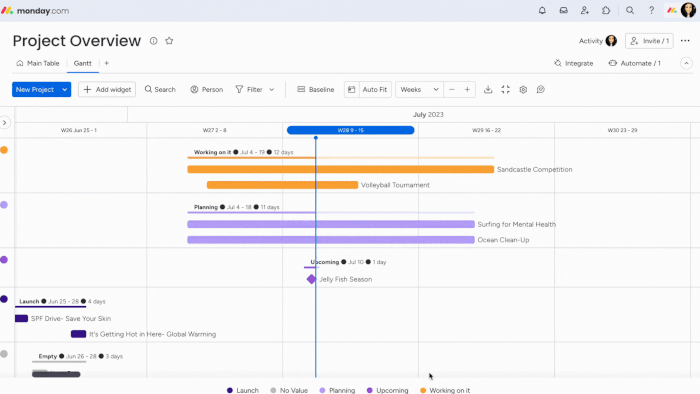
View your project’s critical path with one glance on monday.com (Source: monday.com)
- Critical path: monday.com provides visibility on the longest duration of tasks in your project, letting you identify the most important to-dos and dependencies quickly. This feature is available in your Gantt chart settings.
- Quick search: Find any content in your workspace by entering “Command or Ctrl + B” on your keyboard. Key in the name of the board or attachment you’re looking for in the search bar, and the system automatically displays relevant results based on your query.
- Conditional coloring: Enable the cells in your board to display specific colors automatically when you enter data satisfying predefined criteria. This lets you quickly distinguish tasks from one another without the manual work of assigning categories or labels on them.
Trello: Best for Ease of Use

What We Like
- Entry-level plan features unlimited boards and custom fields
- Setting up automation is easier with Trello's bot, Butler
- All features on the desktop version are available on mobile
Where It Falls Behind
- Lacks native analytics and reporting tool
- Public board management is exclusively offered in the most expensive plan
- Doesn't provide a time tracking feature
How It Compares to ClickUp
- Trello is slightly more affordable than ClickUp, with its entry-level plan priced at $6 per user (versus ClickUp’s $10 per user).
- Trello allows 250 automation runs a month in its free plan, whereas ClickUp offers 100 credits only. Moreover, Trello supports unlimited automations in its Premium and Enterprise plans. ClickUp has a maximum of 250,000 automations in its most expensive plan.
- While ClickUp has less than 50 native third-party integrations, Trello connects seamlessly with 200+ apps.
- Both plans feature two-factor authentication in all subscription plans, including the free version.
Among the best ClickUp alternatives listed here, Trello is our top recommended platform for ease of use. Its simple Kanban interface makes work easier for team members who are new to using project management software solutions. It helps that the platform offers hundreds of workflow templates, eliminating the need to build virtual workspaces from scratch.
When you use these templates, the board is automatically set up for you. The columns and cards are labeled according to your chosen industry or niche-specific workflow. With Trello’s drag-and-drop functionality, it’s easy to update the board as you make progress on tasks.
While Trello is a great alternative to ClickUp for its ease of use, it lacks advanced analytics and reporting features. monday.com has a far better tool, offering work performance insights and a pivot board, which allows users to slice and dice data to unlock more performance trends.
Trello Monthly Pricing at a Glance (per User)*
- Free: Unlimited cards, activity logs, and third-party integrations, a maximum of 10 boards per workspace, and custom backgrounds and stickers
- Standard: $6 for unlimited boards, custom fields, advanced checklists, and 1,000 workspace command runs
- Premium: $12.50 for different project views (calendar, timeline, table, dashboard, and map), unlimited workspace command runs, and workspace-level templates
- Enterprise: $17.50 for 50 users, unlimited workspaces, multi-board guests, attachment permissions, and free single sign-on
- Free trial: 14 days
*The Standard and Premium subscription rates lower to $5 and $10 when you pay annually; the Enterprise plan is only billed annually.
Trello Features
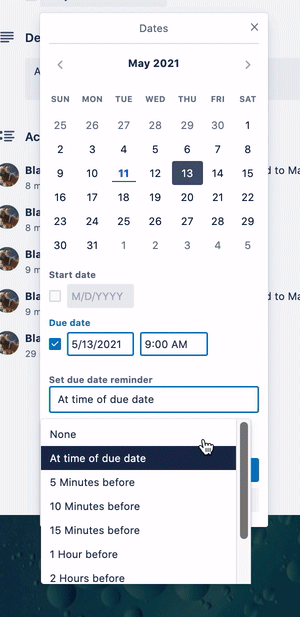
Add due date reminders on Trello tasks
(Source: Trello)
- Card covers: Make your Kanban board more engaging by uploading photos on the cards. Aside from adding aesthetic appeal to your workspace, it’s easier to differentiate tasks from one another given the visual cues.
- Due date reminders: Never miss an important deadline by setting a due date reminder as you create tasks. You have the option to set it days, hours, or minutes before the deadline.
- Dashboard view: Get excellent insights about how your team works by looking at the number of cards per list, label, member, or due date. Trello displays data in charts and graphs to make them easily understandable.
Wrike: Best for AI Functionalities

What We Like
- Gantt charts are available in the entry-level plan
- Project risk forecast is powered by AI
- Supports mobile phone voice commands
Where It Falls Behind
- Users must upgrade to the most expensive subscription plan to access two-step verification
- Wrike Integrate, which lets users connect the platform to third-party apps, is offered as an add-on
- Limited file storage, with the most expensive plan having 15GB per user only
How It Compares to ClickUp
- ClickUp’s free plan offers a maximum of 100MB storage, while Wrike provides 2GB.
- ClickUp’s white labeling feature is locked behind its most expensive plan. Wrike’s branded workspace is available in its second-tier subscription package.
- Unlike ClickUp, Wrike has a budgeting feature that lets businesses keep track of project costs.
- Both ClickUp and Wrike have built-in file proofing and approval tools.
When it comes to robust artificial intelligence (AI), Wrike is among the best ClickUp competitors. While ClickUp offers AI as an add-on, requiring a separate subscription fee, Wrike includes this feature in its plans, even in the free version. The free version features smart replies, which recommend responses after analyzing messages, and generative AI, which automatically creates project briefs and plans.
Part of Wrike’s capabilities is AI-recommended tasks, suggesting to-dos based on importance and priority level. The AI project risk prediction alerts users about potential delays, as it analyzes historical patterns and frequent issues.
The disadvantage of using Wrike is its limited file storage. The most expensive plan restricts storage to 15GB per user. Other ClickUp competitors, like Asana, Jira, and Smartsheet, offer unlimited file storage.
Wrike Monthly Pricing at a Glance (per User)
- Free: Unlimited users, 2GB of file storage, task management, table and Kanban views, and smart search
- Team: $9.80 for two to 25 users, 2GB of file storage per user, calendars and dynamic Gantt chart, analytics view, and 50 automations per user
- Business: $24.80 for five to 200 users, 5GB of file storage per user, project blueprints, cross-tagging, AI risk prediction, and 200 automations per user
- Enterprise: Custom pricing for five to unlimited users, 10GB of file storage per user, custom access roles, single sign-on, and 1,000 automations per user
- Pinnacle: Custom pricing for five to unlimited users, 15GB of file storage per user, locked spaces, budgeting, resource bookings, and 1,500 automations per user
- Free trial: 14 days
Wrike Features
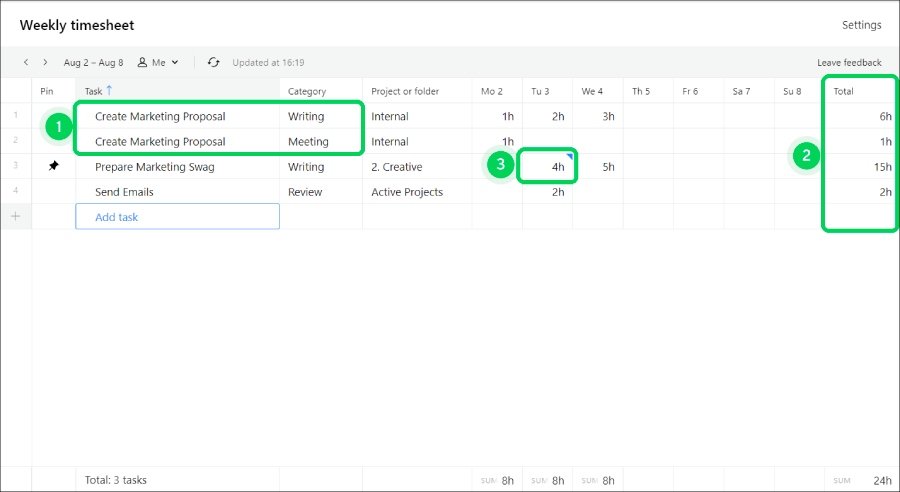
Know how many hours team members spend on different tasks on Wrike’s timesheet (Source: Wrike)
- Personal work schedules: Custom work schedules—by plotting schedules, you’ll be able to know how holidays and team members’ working days impact your project timeline. This will give you a realistic projection of completion.
- Resources view: Get an overview of how team members are distributed for different tasks. It’s easier to monitor who works on what and ensure that the to-dos are evenly assigned.
- Timesheets: This displays the tasks team members have worked on and the hours they spent on each assignment. Wrike automatically populates timesheets when you enable the time tracking feature for a given week.
Asana: Best for Small Teams Handling Multiple Projects

What We Like
- Longer free trial duration than other providers
- List, board, and calendar views are available in the free plan
- Offers the option to restrict edit access on custom fields
Where It Falls Behind
- Businesses must choose the most expensive subscription plan to access 24/7 support
- Beginners take some time to navigate the platform
- Entry-level plan doesn't have the time tracking feature
How It Compares to ClickUp
- Unlike ClickUp, Asana features a project overview, which contains all the information team members need to know about the project.
- Asana provides unlimited free guests in its entry-level plan. On ClickUp, you get five guest seats for one paid user and two guest seats for each additional paid user.
- ClickUp connects with almost 50 third-party apps, while Asana works with over 300 platforms.
- Both solutions provide custom fields in their base-level subscription packages.
With unlimited projects and file storage in the free plan, Asana is the best free ClickUp alternative for small, budget-conscious teams working on multiple projects. The free version also includes unlimited tasks, messages, and activity logs. It features different project views, namely list, board, and calendar, enabling you to be flexible in overseeing tasks.
The project overview, which is also available in the free version, is a centralized virtual hub of all things related to the project, displaying team member roles, key resources, milestones, and status updates. On top of this, you get access to 100-plus integrations on this excellent ClickUp alternative for free.
While Asana offers great features in its free plan, you must upgrade to its most expensive package to get 24/7 support, which costs $30.49 per user. In contrast, monday.com offers round-the-clock assistance, starting in its $10 entry-level plan. If you want to explore more zero-cost solutions, refer to our buyer’s guide on the best free project management software solutions.
Asana Monthly Pricing at a Glance (per User)*
- Basic: Free for unlimited tasks, projects, and activity logs, list, calendar, and board views, time tracking, and third-party integrations
- Premium: $13.49 for unlimited dashboards and free guests, custom fields, milestones, and workflow builder
- Premium: $30.49 for workload, approvals, lock custom fields, time tracking, and advanced reporting
- Free trial: 30 days
*The Premium and Business subscription rates lower to $10.99 and $24.99, respectively, when you pay annually.
Asana Features
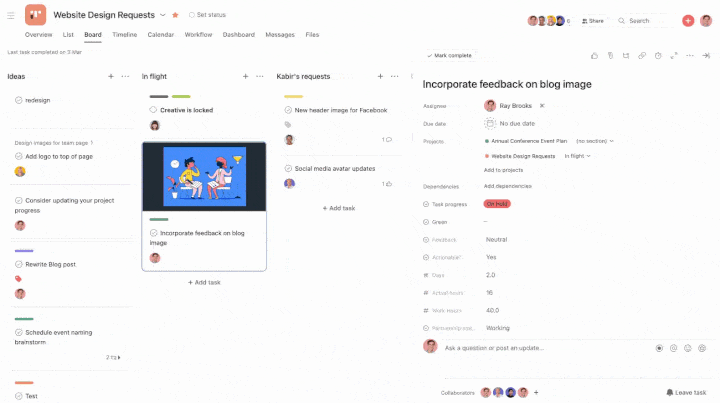
Make comments on collaterals using Asana’s proofing tool (Source: Asana)
- Milestones: This chart outlines the most important tasks of a project. It helps you gauge how much your team has accomplished and how much more you need to finish.
- Proofing: Let team members know what you think about the documents shared in task tickets. When you open a preview of the document, you’ll find the “Add feedback” option on the right-hand side of the interface, allowing you to type a comment.
- Lock custom fields: Prevent other users from accidentally changing the data entered in custom fields. Do note that this feature is only available for Business and Enterprise subscribers.
Jira: Best for Software Development

What We Like
- Generous file storage in the free plan
- Unlimited workflow automations
- Low- to no-code analytics dashboard builder
Where It Falls Behind
- Uptime guarantee is locked behind expensive plans
- Limited collaboration features
- May be complicated for some new users
How It Compares to ClickUp
- Unlike ClickUp, Jira’s search tool is powered by machine learning.
- While ClickUp doesn’t have an uptime guarantee, Jira offers a 99.95% service level agreement in its most expensive plan.
- Jira’s free plan features 2GB of file storage, while ClickUp is restricted to 100MB.
- Both providers offer encryption in-transit and at-rest.
Jira should be your top choice among the best alternatives to ClickUp if you’re working on software development projects. It allows you to view sprints on a board and assign issues to sprints, making monitoring and managing task progress easier. Its product sandboxes let users experiment and introduce changes to the software without affecting the actual platform.
Manage your project’s versions by checking the Release page, the section that outlines the summary and breakdown of issues in a version. The Release burndown report is likewise useful in software development projects, as it displays the estimated number of sprints required to finish the rest of the tasks and the number of scope changes. Ultimately, it helps measure the team’s progress and predict project completion time.
Before choosing Jira, note that there might be a slight learning curve when using it, especially for new users. If you want an easier-to-use platform, the best ClickUp alternatives are Trello and monday.com.
Jira Monthly Pricing at a Glance (per User)
- Free: Maximum of 10 users, unlimited project boards, 100 global and multi-project automation rules, reporting and insights, and 2GB of file storage
- Standard: $7.75 for a maximum of 35,000 users, 500 global and multi-project automation rules, and 250GB of file storage
- Premium: $15.25 for 1,000 global and multi-project automation rules, capacity management, project archiving, 99.9% uptime guarantee, and unlimited storage
- Enterprise: Custom pricing for unlimited global and multi-project automation rules, chart and dashboard builder, and 99.95% uptime guarantee
- Free trial: 7 days
Jira Features
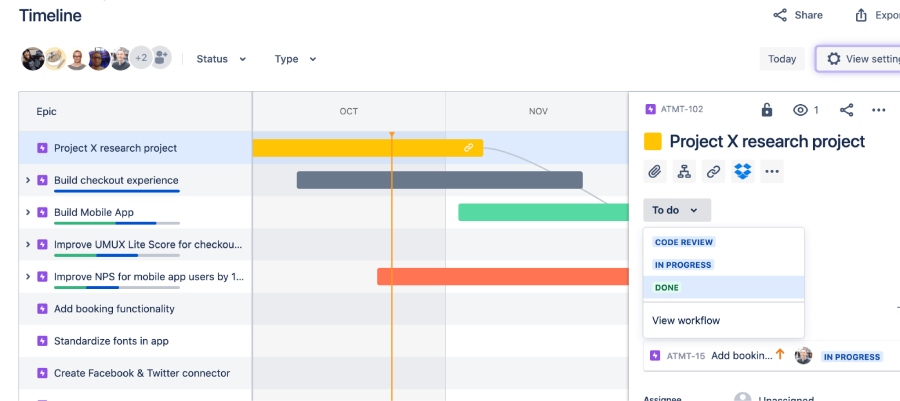
Identify large actionable steps with Jira’s epic feature (Source: Jira)
- Epic: In agile software development, this refers to a large user story that must be finished over a period of time. Jira allows you to create epics in timeline views and break them down into smaller tasks by adding stories or child issues under them.
- Advanced roadmaps: Build a roadmap based on work from several boards, projects, and filters. Create multiple levels of hierarchy above the epic level.
- Project archiving: Move inactive projects to the archives and store them for future reference. With this, your main workspace will be dedicated to the campaigns you’re currently working on, allowing you to quickly find specific projects.
Smartsheet: Best for Spreadsheet-based Project Management

What We Like
- Wide range of workflow templates
- Unlimited dashboards in the free plan
- Robust security features, including approved domain sharing, schedule backups, and system admin fallback
Where It Falls Behind
- May be intimidating for beginners
- Resource management tools require an extra fee
- Integrates with fewer than a hundred third-party apps
How It Compares to ClickUp
- Smartsheet’s free plan has 500MB of file storage, whereas ClickUp offers 100MB.
- While ClickUp offers 100 uses of reporting dashboards in the free version, Smartsheet allows unlimited use.
- Smartsheet and ClickUp feature approvals in all their subscription plans, but ClickUp restricts its use to 100 credits in the free and entry-level packages.
- Both providers offer the dependencies feature in all plans.
Smartsheet is the best ClickUp alternative for teams using spreadsheets when plotting workflow tasks. It features a spreadsheet-style grid that contains task management elements, like task name, duration, assignee, and status. When you switch to the Gantt chart view, the elements are still laid out in a spreadsheet, with the different days of the week in the columns aligned to specific cells.
The platform features robust project management capabilities, including tracking milestones and critical paths, managing resources, and configuring workflow automations. However, it only connects with less than a hundred third-party apps. If you need a solution similar to ClickUp with robust integrations, Asana is the best choice, seamlessly working with 300-plus platforms.
Smartsheet Monthly Pricing at a Glance (per User)*
- Free: One user and two editors, Gantt and calendar views, unlimited dashboards and reports, 500MB of file storage, and 100 automations
- Pro: $12 for unlimited users and 10 editors, unlimited forms, resource and digital management, 20GB of file storage, and 250 automations
- Business: $24 for conditional form logic, activity log, proofing, 1TB of file storage, unlimited number of automations
- Enterprise: Custom pricing for work insights, access to no-code app builder, single sign-on, and unlimited storage
- Free trial: 30 days
*The Pro and Business subscription rates lower to $9 and $19 per user when you pay annually.
Smartsheet Features
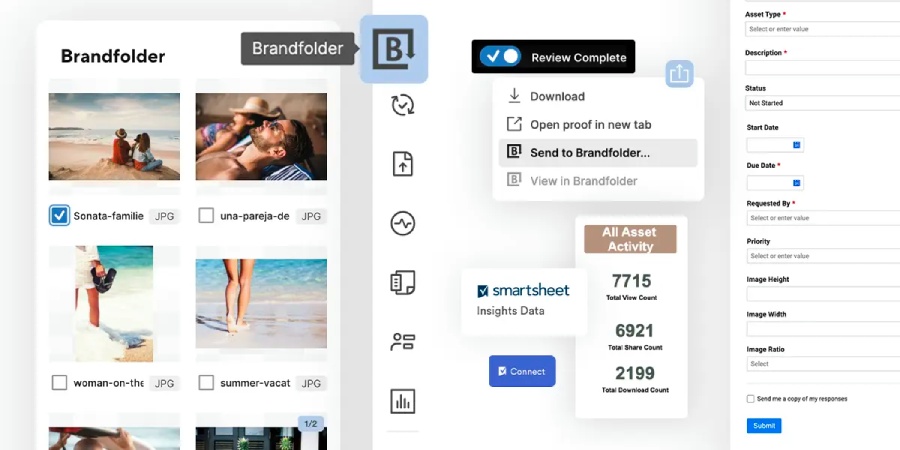
Manage company collaterals in Smartsheet’s Brandfolder (Source: Smartsheet)
- Cell history: See who made changes to the cells in your spreadsheet, and when the edits were made. If you need to bring back previous information, copy-paste the details shown in the view cell history pop-up.
- Update request: Configure automations to programmatically ask a team member to provide an update on tasks. For example, you can set the request when a date is reached or when rows are added or changed.
- Brandfolder: Keep all your digital collaterals in one place. Approve or share feedback on uploaded documents and images right within the Brandfolder.
How We Evaluated the Best ClickUp Alternatives
To assess ClickUp substitutes, we developed a rubric that assigns scores to the software solution’s affordability, project management tools, ease of use, and technical assistance. In addition, we included our evaluation of the provider’s popularity and unique capabilities.
Learn how we evaluated the best ClickUp substitutes by clicking on the tabs below:
20% of Overall Score
We checked if the providers offer a free plan and discounts for annual billing and bulk users. Those catering to a wider set of business budget needs, offering more than three subscription plans, earned more points. To assess affordability further, we considered how the entry-level subscription plan fared against the prevailing rate in the market.
25% of Overall Score
Task reminders, file storage, and mobile apps were the general features we took into consideration in our evaluation. We gave extra points to providers offering a mobile app and supporting on-the-go teams.
20% of Overall Score
The niche capabilities we checked were milestone tracking, Kanban and list view, and comma-separated values (CSV) and Excel data export. Providers with robust integrations also earned more points.
10% of Overall Score
An intuitive interface is one of our considerations in ease of use. We checked if technical skill is necessary to set up and operate the platform.
10% of Overall Score
Since technical issues can happen anytime, we favored providers with 24/7 customer support operations. Those present in various communication channels, namely phone, email, and live chat, got extra points.
15% of Overall Score
Part of our expert score is value for money. We also took into account each provider’s standout features and ease of use. As for popularity, we referred to third-party review sites to see if users were familiar with the platform.
Frequently Asked Questions (FAQs)
No, Google doesn’t have its own project management app like ClickUp. However, Google Chat allows users to create and organize tasks on a Space or group chat. Advanced task management tools, like different project views and time tracking, are not available.
While both platforms are used for team collaboration, Slack and ClickUp have different primary functions. Slack is an instant messaging tool that allows users to chat with one another and create private and public channels to broadcast messages to a larger group of audience.
ClickUp is a project management solution that enables businesses to oversee projects, monitor tasks, and manage resources. Some of the popular ClickUp similar apps are monday.com and Trello.
No, ClickUp’s free version is limited. It only allows up to five Spaces, 100MB of file storage, 100 uses of Gantt chart and timeline views, and one week of activity log. If you’re looking for a good ClickUp free alternative, Asana is your best option, as it offers unlimited projects, storage, and activity logs.
Bottom Line
The best alternatives to ClickUp feature a simple, intuitive interface that makes navigation within the platform effortless. The free version offers robust features, like generous storage and longer activity log duration.
Among the software solutions we reviewed, monday.com is the best overall, as it provides an easy-to-use platform and valuable tools in its free version. More importantly, it facilitates seamless team collaboration, enabling users to start discussions, upload documents within task tickets, and discuss tasks in virtual meetings via Zoom integration. Try monday.com’s forever-free plan to learn if it suits your project management needs.


